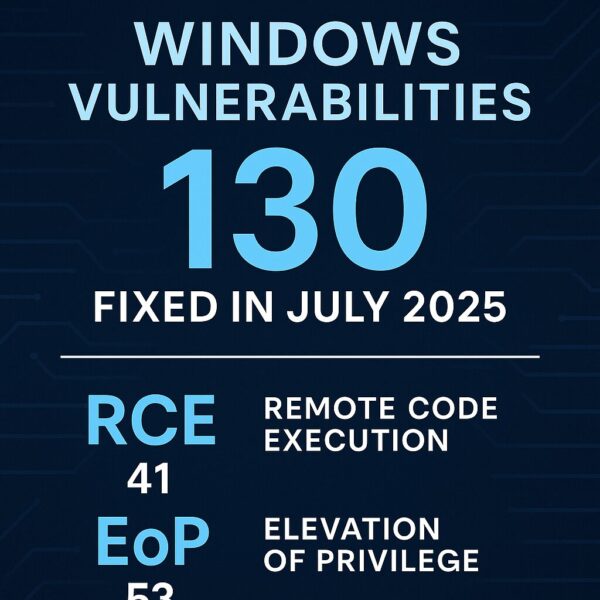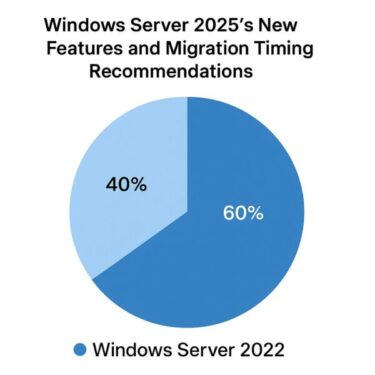
Microsoft’s Patch Tuesday for July 2025 brings a substantial set of updates, addressing 130 security vulnerabilities (CVEs) across multiple Windows products. Among them are 41 Remote Code Execution (RCE) vulnerabilities and 53 Elevation of Privilege (EoP) flaws—two of the most dangerous categories that threat actors routinely exploit.
If you’re running Windows in any form—personal, enterprise, or server—The July 2025 patch is not just recommended, it’s crucial.
What Is Patch Tuesday?
Patch Tuesday is Microsoft’s monthly release cycle for security and reliability updates. Occurring on the second Tuesday of each month, this schedule allows organizations to plan and prioritize patch deployments systematically.
The July 2025 edition is particularly notable—not only for the volume of vulnerabilities fixed, but for the growing risks posed to Windows 10 (which nears end-of-support in October 2025) and new attack surfaces introduced in Windows 11 version 24H2.
Breakdown of the 130 Vulnerabilities
| Category | Number of Issues | Description |
|---|---|---|
| Remote Code Execution (RCE) | 41 | Allows remote attackers to execute arbitrary code |
| Elevation of Privilege (EoP) | 53 | Allows escalation from user to admin/system level |
| Information Disclosure | 17 | Leaks sensitive system or user information |
| Denial of Service (DoS) | 9 | Causes system or application to crash/freeze |
| Security Feature Bypass | 6 | Disables or bypasses security mechanisms |
| Others | 4 | Unclassified or design-related vulnerabilities |
The high volume of RCE and EoP entries should not be underestimated—these are the types of vulnerabilities most likely to be exploited in the wild.
Critical CVEs to Watch
Some of the most serious vulnerabilities fixed this month include:
- CVE-2025-47981
High-risk RCE vulnerability affecting Outlook. May be triggered without user interaction via specially crafted email content. - CVE-2025-48799
Local privilege escalation flaw in Windows Kernel, potentially allowing attackers to gain SYSTEM-level access. - CVE-2025-49717
An RCE affecting SMB protocol, exploitable over internal networks—especially risky in enterprise environments. - CVE-2025-49696
Information disclosure flaw in NTFS file system, which could be used to leak metadata or system paths.
Affected Products
This update affects a wide range of Microsoft products, including:
- Windows 10 (version 22H2)
- Windows 11 (21H2 through 24H2)
- Windows Server 2022 / 2019 / Azure Stack HCI
- Microsoft Office (Word, Excel, Outlook)
- Exchange Server, SharePoint Server
- .NET, Visual Studio, Microsoft Teams, Defender
If you are running any of the above, immediate patching is highly recommended.
Why This Month Matters More Than Usual
Several factors make the July 2025 Patch Tuesday cycle especially important:
- Windows 10 will reach end-of-support in October 2025—just 3 months away.
- Windows 11 version 24H2 is newly released and still stabilizing.
- Many of these vulnerabilities had public disclosure or active exploitation hints.
Attackers often ramp up efforts in the final months before a system’s lifecycle ends, making now a critical time for protection.
What Should Home Users Do?
- Run Windows Update immediately and install all available security patches.
- If you’re using Outlook, Edge, or Office apps—make sure they are updated as well.
- Avoid opening suspicious files or emails and keep SmartScreen and antivirus active.
IT Admin Recommendations
- Prioritize patching CVEs with CVSS scores ≥ 8.0
- Stage and test updates before full rollout using WSUS or Intune
- Check for conflicts with endpoint protection (Defender for Endpoint or third-party EDRs)
- Use PowerShell scripts to verify patch levels by CVE
- Reassess group policies related to SMB, macros, and unsigned scripts
FAQ – Frequently Asked Questions
Q: Do I need to review all 130 CVEs?
A: No. Focus on those relevant to your system or software stack. This article highlights the most severe ones.
Q: Will Windows Update include past unpatched CVEs?
A: Yes. Microsoft uses cumulative updates—applying the latest one brings all previous fixes too.
Q: What if the update causes issues?
A: Use the “Uninstall updates” option in Settings or revert to a restore point if you’ve created one.
Conclusion
The July 2025 security update isn’t just another monthly patch—it’s a major milestone in Microsoft’s effort to close dangerous gaps before major lifecycle transitions. With 130 vulnerabilities addressed, and dozens categorized as RCE or EoP, this is not a month to postpone patching.
Stay safe, stay updated—and revisit your patching strategy as we approach the end of Windows 10’s support lifecycle.
✔️You might also find these helpful:
▶︎How to Upgrade an Unsupported PC to Windows 11 24H2
▶︎[2025 Guide] Install Windows 11 24H2 on Unsupported PCs
💡 Looking for more tips? Check out our full list of Windows Help Guides.


